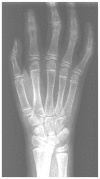Molecular characterization of a de novo 6q24.2q25.3 duplication interrupting UTRN in a patient with arthrogryposis
- PMID: 20583184
- PMCID: PMC2962443
- DOI: 10.1002/ajmg.a.33433
Molecular characterization of a de novo 6q24.2q25.3 duplication interrupting UTRN in a patient with arthrogryposis
Abstract
Chromosome 6q duplications have been documented repeatedly, allowing the delineation of a "6q duplication syndrome," characterized by hypertelorism, downslanting palpebral fissures, tented upper lip, short neck, severe mental and growth retardation, and joint contractures. Most reported cases result from malsegregation of a reciprocal translocation leading to a terminal 6q duplication and partial monosomy of another chromosome. Only 11 cases of de novo pure duplication have been reported so far. The breakpoints do not appear to be recurrent, but in most cases they have not been characterized molecularly, precluding genotype-phenotype correlation. We report on an 8-year-old girl with a phenotype consistent with mild 6q duplication syndrome, including characteristic physical findings, mild mental retardation, and joint contractures. She carries a 13 Mb de novo 6q24.2q25.3 duplication, diagnosed by high-resolution karyotype and confirmed by array-CGH. Molecular characterization of the duplicated segment with quantitative PCR showed that the proximal breakpoint is localized within the UTRN gene, encoding utrophin, the autosomal homologue of dystrophin. We discuss the possible implication of UTRN in arthrogryposis associated with duplications spanning the 6q23q26 region.
(c) 2010 Wiley-Liss, Inc.
Figures






Similar articles
-
A 15Mb duplication of 6q24.1-q25.3 associated with typical but milder features of the duplication 6q syndrome.Eur J Med Genet. 2008 Jul-Aug;51(4):358-61. doi: 10.1016/j.ejmg.2008.01.005. Epub 2008 Feb 8. Eur J Med Genet. 2008. PMID: 18342594
-
Pure de novo 17q25.3 micro duplication characterized by micro array CGH in a dysmorphic infant with growth retardation, developmental delay and distal arthrogryposis.Genet Couns. 2010;21(1):25-34. Genet Couns. 2010. PMID: 20420026
-
Interstitial 6q duplication in an adult male without growth delay or severe mental retardation.Med Sci Monit. 2000 May-Jun;6(3):581-5. Med Sci Monit. 2000. PMID: 11208374
-
Mild "duplication 6q syndrome": a case with partial trisomy (6)(q23.3q25.3).Am J Med Genet. 1997 Feb 11;68(4):450-4. doi: 10.1002/(sici)1096-8628(19970211)68:4<450::aid-ajmg15>3.0.co;2-r. Am J Med Genet. 1997. PMID: 9021020 Review.
-
De novo 1q32q44 duplication and distal 1q trisomy syndrome.Am J Med Genet A. 2003 Jul 15;120A(2):229-33. doi: 10.1002/ajmg.a.20028. Am J Med Genet A. 2003. PMID: 12833404 Review.
Cited by
-
Autism multiplex family with 16p11.2p12.2 microduplication syndrome in monozygotic twins and distal 16p11.2 deletion in their brother.Eur J Hum Genet. 2012 May;20(5):540-6. doi: 10.1038/ejhg.2011.244. Epub 2012 Jan 11. Eur J Hum Genet. 2012. PMID: 22234155 Free PMC article.
-
Complex nature of apparently balanced chromosomal rearrangements in patients with autism spectrum disorder.Mol Autism. 2015 Mar 25;6:19. doi: 10.1186/s13229-015-0015-2. eCollection 2015. Mol Autism. 2015. PMID: 25844147 Free PMC article.
-
Interstitial 6q21q23 duplication - variant of variable phenotype and incomplete penetrance or benign duplication?Mol Cytogenet. 2016 Jun 2;9:43. doi: 10.1186/s13039-016-0253-9. eCollection 2016. Mol Cytogenet. 2016. PMID: 27274769 Free PMC article.
-
The Genomics of Arthrogryposis, a Complex Trait: Candidate Genes and Further Evidence for Oligogenic Inheritance.Am J Hum Genet. 2019 Jul 3;105(1):132-150. doi: 10.1016/j.ajhg.2019.05.015. Epub 2019 Jun 20. Am J Hum Genet. 2019. PMID: 31230720 Free PMC article.
-
Duplication 6q24: More Than Just Diabetes.J Endocr Soc. 2020 Apr 27;4(5):bvaa027. doi: 10.1210/jendso/bvaa027. eCollection 2020 May 1. J Endocr Soc. 2020. PMID: 32373772 Free PMC article.
References
-
- Brøndum-Nielsen K, Bajalica S, Wulff K, Mikkelsen M. Chromosome painting using FISH (fluorescence in situ hybridization) with chromosome-6-specific library demonstrates the origin of a de novo 6q+ marker chromosome. Clin Genet. 1993;43:235–9. - PubMed
-
- Cappon SL, Duncan AM, Khalifa MM. Interstitial 6q duplication in an adult male without growth delay or severe mental retardation. Med Sci Monit. 2000;6:581–5. - PubMed
-
- Causio F, Fischetto R, Carnevale F, Pansini A, Rocchi M. Trisomy 6q syndrome: a case with a de novo 6q23 tandem duplication. Genet Couns. 2001;12:145–50. - PubMed
-
- Dallapiccola B, Bricarelli FD, Quartino AR, Mazzilli MC, Chisci R, Gandini E. Delineation of syndromes due to partial 6q imbalances. Trisomy 6q21 leads to qter and monosomy 6q221 leads to qter in two unrelated patients. Acta Genet Med Gemellol (Roma) 1978;27:57–66. - PubMed
Publication types
MeSH terms
Substances
LinkOut - more resources
Full Text Sources
Other Literature Sources
Miscellaneous

